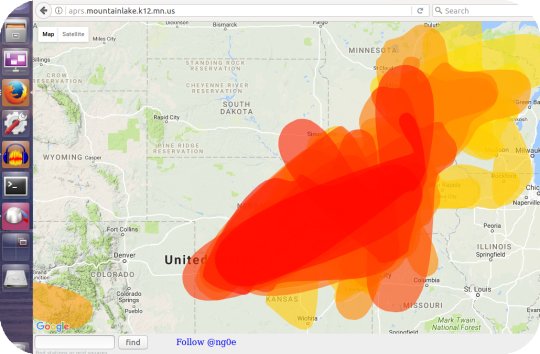Jake (ke0nkc) in South Dakota was one of several distant hams on the SWIARC 82 repeater Saturday night (7/22/17) talking with Albert (ke0lol) and some other locals. They were also making the trip from northern and eastern Iowa to north Nebraska. Stations 200 miles away were talking on the club repeater, some full quieting.
Here’s some of the hams using the 146.82 repeater Saturday night:
- kd0sja – (EN21)
- kb0lox / Eric – (EN23 )
- n2am / Kevin – (EN41no)
- kd0akq – Holstein Iowa
- ke0scs / Selina – (EN22kx)
- n0skf / Dusty – Ottumwa Ia
- kd0tto / Ron – Des Moines
- kb0qcr – Estherville Iowa
- ke0nkc / Jake – South Dakota
This is a partial list. 23:00 – 23:59 – go ahead and look these up to verify callsigns because they are posted here as they were scribbled down!
Selina of Rembrandt, IA was sitting in her car talking on the SWIARC repeater while her husband was in their house working VHF SSB.
Sunday morning at around 9:00am the band was still open and Dusty was still able to use the SWIARC repeater.
Tips:
1.) Don’t call “CQ CQ” on the repeater. Even when the band is open this is a n00b move.
2.) When you discover an opening, try to work stations simplex. Contesting and logs are SIMPLEX oriented. It’s neat to hear em though the repeater, but that’s technically them contacting the 82 repeater, not you contacting them.
3.) If you don’t hear the distant ham on the repeater input then you probably won’t be able to work that station simplex. What you could do is ask the ham for the frequency of a repeater in his or her area then try to work that repeater from your station. Goes against #2? Well not really if you’re recording it as contacting a distant repeater, however, it’s still a novelty.
4.) Know your gridmap gridsquare – it’s a VHF thing! Look up someone’s grid square.

By 5:00am paths were presented by APRS stations reaching from Iowa to the west cost. The red color represents distances of 465 miles and greater!
VHF Propagation Map
The web site URL is: http://aprs.mountainlake.k12.mn.us/ <- This is a very cool web site. It uses real time APRS beacons to determine actual propagation rather than an arbitrary prediction model.
This map shows actual radio propagation from stations operated near 144 MHz. It uses data gathered by Automatic Packet Reporting System-Internet Service (APRS-IS).
Summertime Skipp’n
So what is this tropospheric ducting and how does it relate to other VHF? Firstly, you’re going to hear hams say “tropospheric ducting is not skip” and technically they’re right.
When it’s hot outside, which it has been here lately, and there is a high-pressure system nearby, the atmosphere turns into a blanket of warm air over a lower layer of cool air by evening. Rather than the ionosphere bending radio signals back down to the ground, the layer of air is doing this giving us enhanced signal propagation on VHF. This type of propagation primarily impacts frequencies above 100MHz and can also create some favorable conditions all the way up to the 70cm band.
There is a tropospheric ducting prediction site called Worldwide Tropospheric Ducting Forecasts. They produce daily maps and predictions based on weather patterns.
Unlike sporadic-E, tropospheric ducting favors the night and is somewhat more predictable. Technically there is a condition of tropospheric conducting or enhancement that is distinct from tropospheric ducting, but that’s splitting hairs. The cool thing about this type of propagation is that there’s no dead zone inbetween the path. See, it’s not skip!
K0SWI / 146.82 Repeater Grid Square
Call K0SWI found for SOUTHWEST IOWA AMATEUR RADIO CLUB
Address found: Box 661 Council Bluff IA 51502 United States
Latitude: 41.261 / 41° 15′ 39″ N Longitude: -95.852 / 95° 51′ 7″ W
Grid: EN21bg (QRZ: EN21cg)
Rich, is this based on the mailing address or tower location?
What we really want distant stations to know when they happen to make it into the SWIARC repeater is the location of the repeater and not necessarily your QS. If in turn you can hear them on the input then it is likely you’d be able to QSO w/o the repeater involved.
